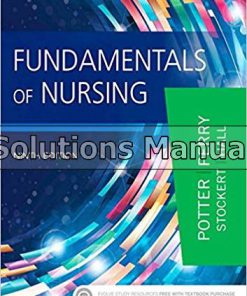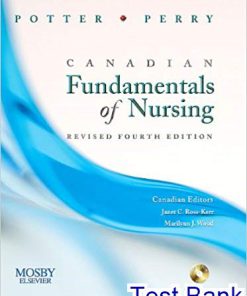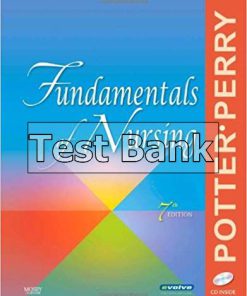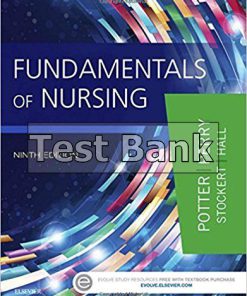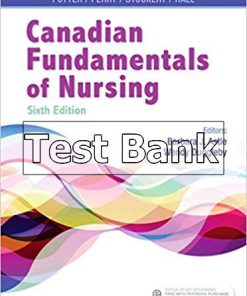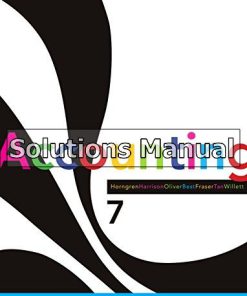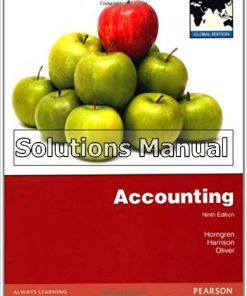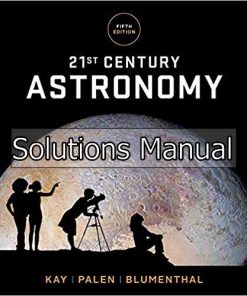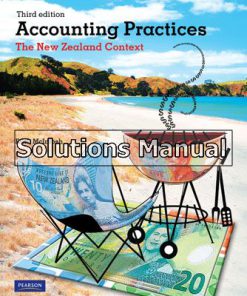Canadian Fundamentals of Nursing 5th Edition Potter Solutions Manual
$26.50$50.00 (-47%)
Canadian Fundamentals of Nursing 5th Edition Potter Solutions Manual.
You may also like
Canadian Fundamentals of Nursing 5th Edition Potter Solutions Manual
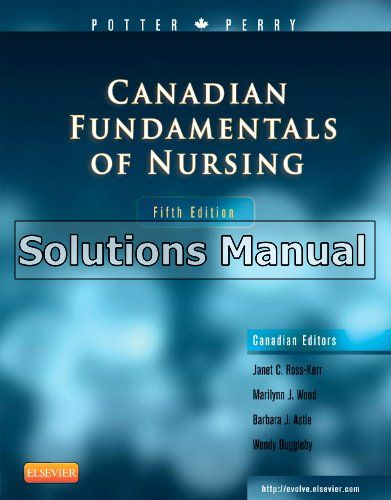
Product details:
- ISBN-10 : 1926648536
- ISBN-13 : 978-1926648538
- Author: Patricia A. Potter
Thoroughly updated to include the latest emerging issues and protocols in Canadian nursing practice, Canadian Fundamentals of Nursing, 5th Edition combines unparalleled Canadian nursing coverage with extensive learning support to help you easily master the basic nursing principles and procedures. The Potter team’s proven, student-friendly approach describes the principles, concepts, and skills essential to your success. This edition has also been thoroughly reviewed by Canadian nursing experts to ensure that you are well prepared to practice in Canada.
Table contents:
- 1 Health and Wellness
- Preliminary Reading
- Comprehensive Understanding
- Conceptualizations of Health
- Historical Approaches to Health in Canada
- Determinants of Health
- Strategies to Influence Health Determinants
- Health Promotion Strategies
- Population Health Promotion Model: Putting It All Together
- Review Questions
- Chapter 1: Health and Wellness
- Answer Key to Study Guide
- 2 The Canadian Health Care Delivery System
- Preliminary Reading
- Comprehensive Understanding
- Evolution of the Canadian Health Care Systemprimarily
- The Organization and Governance of Health Care
- Health Care Spending
- Trends and Reforms in Canada’s Health Care System
- Right to Health Care
- Primary Health Care
- Settings for Health Care Delivery
- Levels of Care
- Challenges to the Health Care System
- Review Questions
- Chapter 2: The Canadian Health Care Delivery System
- Answer Key to Study Guide
- 3 The Development of Nursing in Canada
- Preliminary Reading
- Comprehensive Understanding
- Highlights of World Nursing History
- Early History of Nursing in Canada
- Globalization and the Emergence of Modern Nursing
- Nursing Education in Canada
- Health Care and Educational Reform
- Influence of Periods of Social Upheaval on Nursing
- Review Questions
- Chapter 3: The Development of Nursing in Canada
- Answer Key to Study Guide
- 4 Community Health Nursing Practice
- Preliminary Reading
- Comprehensive Understanding
- Promoting the Health of Populations and Community Groups
- Community Health Nursing Practice
- The Changing Focus of Community Health Nursing Practice
- Community Assessment
- Promoting Patients’ Health
- Review Questions
- Chapter 4: Community Health Nursing Practice
- Answer Key to Study Guide
- II Foundations of Nursing Practice
- 5 Theoretical Foundations of Nursing Practice
- Preliminary Reading
- Comprehensive Understanding
- Early Nursing Practice and the Emergence of Theory
- Nursing Process
- Conceptual Frameworks
- Metaparadigm Concepts
- Philosophy of Nursing Science
- Ways of Knowing in Nursing Practice
- Paradigm Debates Within Nursing
- Nursing Diagnosis
- Reflections on Conceptualizing Nursing
- Major Theoretical Models
- Review Questions
- Chapter 5: Theoretical Foundations of Nursing Practice
- Answer Key to Study Guide
- 6 Research as a Basis for Practice
- Preliminary Reading
- Comprehensive Understanding
- Why Evidence?
- Researching the Evidence
- Evaluate the Practice Decision or Change
- Support for Evidence-Informed Practice
- Knowledge Development in Nursing
- The Development of Research in Nursing
- The History of Nursing Research in Canada
- Nursing Research
- Research Designs
- Ethical Issues in Research
- Applying Research Findings to Nursing Practice
- Review Questions
- Chapter 6: Research as a Basis for Practice
- Answer Key to Study Guide
- 7 Nursing Values and Ethics
- Preliminary Reading
- Comprehensive Understanding
- Values
- Ethics
- Ethical Analysis and Nursing
- Ethical Issues in Nursing Practice
- Review Questions
- Chapter 7: Nursing Values and Ethics
- Answer Key to Study Guide
- 8 Legal Implications in Nursing Practice
- Preliminary Reading
- Comprehensive Understanding
- Legal Limits of Nursing
- Legal Liability Issues in Nursing Practice
- Legal Issues in Nursing Practice
- Risk Management
- Review Questions
- Chapter 8: Legal Implications in Nursing Practice
- Answer Key to Study Guide
- 9 Global Health, Culture, and Diversity
- Preliminary Reading
- Comprehensive Understanding
- Global Health
- Cultural Diversity
- Understanding Cultural Concepts
- Historical Development of the Concept of Culture
- Cultural Assessment
- Selected Components of Cultural Assessment
- Application of Cultural Assessment Components to Aboriginal Peoples of Canada
- Review Questions
- Chapter 9: Global Health, Culture, and Diversity
- Answer Key to Study Guide
- 10 Nursing Leadership, Management, and Collaborative Practice
- Preliminary Reading
- Comprehensive Understanding
- Quality Care and Patient Safety
- Leadership Skills for Nursing Students
- Review Questions
- Chapter 10: Nursing Leadership, Management, and Collaborative Practice
- Answer Key to Study Guide
- III Approaches to Nursing Care
- 11 Critical Thinking in Nursing Practice
- Preliminary Reading
- Comprehensive Understanding
- Critical Thinking Defined
- A Critical Thinking Model for Clinical Decision Making
- Levels of Critical Thinking in Nursing
- Components of Critical Thinking in Nursing
- Critical Thinking Competencies
- Developing Critical Thinking Skills
- Critical Thinking Synthesis
- Review Questions
- Chapter 11: Critical Thinking in Nursing Practice
- Answer Key to Study Guide
- 12 Nursing Assessment and Diagnosis
- Preliminary Reading
- Comprehensive Understanding
- Critical Thinking Approach to Assessment
- Data Collection
- Nursing Diagnosis
- Critical Thinking and the Nursing Diagnostic Process
- Sources of Diagnostic Errors
- Review Questions
- Chapter 12: Nursing Assessment and Diagnosis
- Answer Key to Study Guide
- 13 Planning and Implementing Nursing Care
- Preliminary Reading
- Comprehensive Understanding
- Planning Nursing Care
- Establishing Priorities
- Critical Thinking in Establishing Goals and Expected Outcomes
- Types of Interventions
- Selection of Interventions
- Planning Nursing Care
- Consulting Other Health Care Professionals
- Critical Thinking in Implementation
- Standard Nursing Interventions
- Implementation Process
- Direct Care
- Indirect Care
- Review Questions
- Chapter 13: Planning and Implementing Nursing Care
- Answer Key to Study Guide
- 14 Evaluation of Nursing Care
- Preliminary Reading
- Comprehensive Understanding
- Critical Thinking and Evaluation
- The Evaluation Process
- Review Questions
- Chapter 14: Evaluation of Nursing Care
- Answer Key to Study Guide
- 15 Documenting and Reporting
- Preliminary Reading
- Comprehensive Understanding
- Confidentiality
- Multidisciplinary Communication Within the Health Care Team
- Purposes of Records
- Guidelines for Quality Documentation and Reporting
- Common Documentation Systems
- Common Record-Keeping Forms
- Home Health Care Documentation
- Long-Term Health Care Documentation
- Computerized Documentation
- The Electronic Health Record
- Reporting
- Review Questions
- Chapter 15: Documenting and Reporting
- Answer Key to Study Guide
- 16 Nursing Informatics and Canadian Nursing Practice
- Preliminary Reading
- Comprehensive Understanding
- Nursing Informatics and the Canadian Health Care System
- Standards in Health Informatics
- Canadian Privacy Legislation
- National E-Nursing Strategy
- Clinician Engagement and Informatics Communities
- Review Questions
- Chapter 16: Nursing Informatics and Canadian Nursing Practice
- Answer Key to Study Guide
- IV Working With Patients and Families
- 17 Communication
- Preliminary Reading
- Comprehensive Understanding
- Communication and Interpersonal Relationships
- Developing Communication Skills
- Levels of Communication
- Basic Elements of the Communication Process
- Forms of Communication
- Professional Nursing Relationships
- Elements of Professional Communication
- Communication Within the Nursing Care Process
- Nursing Diagnosis
- Planning
- Implementation
- Evaluation
- Review Questions
- Chapter 17: Communication
- Answer Key to Study Guide
- 18 Caring in Nursing Practice
- Preliminary Reading
- Comprehensive Understanding
- Theoretical Views on Caring
- Patient’s Perceptions of Caring
- Ethic of Care
- Caring in Nursing Practice
- The Challenge of Caring
- Review Questions
- Chapter 18: Caring in Nursing Practice
- Answer Key to Study Guide
- 19 Family Nursing
- Preliminary Reading
- Comprehensive Understanding
- What Is a Family?
- Current Trends in the Canadian Family
- The Family and Health
- Family Nursing Care
- Assessing the Challenges, Strengths, and Needs of the Family: The Calgary Family Assessment Model
- Family Intervention: The Calgary Family Intervention Model
- Review Questions
- Chapter 19: Family Nursing
- Answer Key to Study Guide
- 20 Patient Education
- Preliminary Reading
- Comprehensive Understanding
- Goals of Patient Education
- Teaching and Learning
- Domains of Learning
- Basic Learning Principles
- Integrating the Nursing and Teaching Processes
- Assessment
- Nursing Diagnosis
- Planning
- Implementation
- Evaluation
- Review Questions
- Chapter 20: Patient Education
- Answer Key to Study Guide
- V Caring Throughout the Lifespan
- 21 Developmental Theories
- Preliminary Reading
- Comprehensive Understanding
- Growth and Development
- Traditions of Developmental Theories
- Organicism
- Psychoanalytic and Psychosocial Tradition
- Mechanistic Tradition
- Contextualism
- Dialecticism
- Review Questions
- Chapter 21: Developmental Theories
- Answer Key to Study Guide
- 22 Conception Through Adolescence
- Preliminary Reading
- Comprehensive Understanding
- Selecting a Developmental Framework for Nursing
- Conception
- Transition From Intrauterine to Extrauterine Life
- Newborn
- Infant
- Toddler
- Preschooler
- School-Age Children and Adolescents
- School-Age Child
- Adolescent
- Review Questions
- Chapter 22: Conception Through Adolescence
- Answer Key to Study Guide
- 23 Young to Middle Adulthood
- Preliminary Reading
- Comprehensive Understanding
- Young Adulthood
- Middle Adulthood
- Review Questions
- Chapter 23: Young to Middle Adulthood
- Answer Key to Study Guide
- 24 Older Adulthood
- Preliminary Reading
- Comprehensive Understanding
- Variability Among Older Adults
- Terminology
- Myths and Stereotypes
- Nurses’ Attitudes Toward Older Adults
- Theories of Aging
- Aging Well and Quality of Life
- Community-Based and Institutional Health Care Services
- Assessing the Needs of Older Adults
- Addressing the Health Concerns of Older Adults
- Older Adults and the Acute Care Setting
- Older Adults and Restorative Care
- Review Questions
- Chapter 24: Older Adulthood
- Answer Key to Study Guide
- VI Psychosocial Considerations
- 25 Self-Concept
- Preliminary Reading
- Comprehensive Understanding
- Nursing Knowledge Base
- The Family’s Effect on Development of Self-Concept
- The Nurse’s Effect on the Patient’s Self-Concept
- Self-Concept and the Nursing Process
- Assessment
- Nursing Diagnosis
- Planning
- Implementation
- Evaluation
- Review Questions
- Critical Thinking Model for Nursing Care Plan for Disturbed Body Image
- Chapter 25: Self-Concept
- Answer Key to Study Guide
- 26 Sexuality
- Preliminary Reading
- Comprehensive Understanding
- Scientific Knowledge Base
- Nursing Knowledge Base
- Critical Thinking
- Sexuality and the Nursing Process
- Assessment
- Nursing Diagnosis
- Planning
- Implementation
- Evaluation
- Review Questions
- Critical Thinking Model for Nursing Care Plan for Sexual Dysfunction
- Chapter 26: Sexuality
- Answer Key to Study Guide
- 27 Spiritual Health
- Preliminary Reading
- Comprehensive Understanding
- Historical Perspectives
- Spirituality and Health: Empirical Evidence
- Spirituality and Nursing Theory
- Conceptualizing Spirituality and Religion
- Spirituality and the Life Journey
- Critical Thinking
- Providing Spiritual Care
- Reflecting on Nurses’ Spiritual Care
- Review Questions
- Chapter 27: Spiritual Health
- Answer Key to Study Guide
- 28 The Experience of Loss, Death, and Grief
- Preliminary Reading
- Comprehensive Understanding
- Scientific Knowledge Base
- Nursing Knowledge Base
- The Nursing Process and Grief
- Assessment
- Nursing Diagnosis
- Planning
- Implementation
- Evaluation
- Review Questions
- Critical Thinking Model for Nursing Care Plan for Ineffective Coping
- Chapter 28: The Experience of Loss, Death and Grief
- Answer Key to Study Guide
- 29 Stress and Adaptation
- Preliminary Reading
- Comprehensive Understanding
- Conceptualizations of Stress
- Stress Response Systems
- Stress and the Immune System
- The Relationship Between Type of Stressor and Health
- Nursing Knowledge Base
- Nursing Process
- Assessment
- Nursing Diagnosis
- Planning
- Implementation
- Evaluation
- Review Questions
- Critical Thinking Model for Nursing Care Plan for Caregiver Role Strain
- Chapter 29: Stress and Adaptation
- Answer Key to Study Guide
- VII Scientific Basis for Nursing Practice
- 30 Vital Signs
- Preliminary Reading
- Comprehensive Understanding
- Guidelines for Measuring Vital Signs
- Body Temperature
- Assessment
- Nursing Diagnosis
- Planning
- Implementation
- Evaluation
- Respiration
- Blood Pressure
- Recording Vital Signs
- Review Questions
- Chapter 30: Vital Signs
- Answer Key to Study Guide
- 31 Health Assessment and Physical Examination
- Preliminary Reading
- Comprehensive Understanding
- Social and Cultural Considerations
- Purposes of Physical Examination
- Skills of Physical Assessment
- Preparation for the Physical Examination
- Organization of the Examination
- General Survey
- The Integumentary System—Skin, Hair, and Nails
- Head and Neck
- External Eye Structures
- Thorax and Lungs
- Heart
- Vascular System
- Breasts
- Abdomen
- Female Genitalia and Reproductive Tract
- Male Genitalia
- Rectum and Anus
- Musculoskeletal System
- Neurological System
- Review Questions
- Chapter 31: Health Assessment and Physical Examination
- Answer Key to Study Guide
- 32 Infection Control
- Preliminary Reading
- Comprehensive Understanding
- Scientific Knowledge Base
- Nursing Process in Infection Control
- Assessment
- Nursing Diagnosis
- Planning
- Implementation
- Evaluation
- Review Questions
- Chapter 32: Infection Control
- Answer Key to Study Guide
- 33 Medication Administration
- Preliminary Reading
- Comprehensive Understanding
- Scientific Knowledge Base
- Nursing Knowledge Base
- Critical Thinking
- Nursing Process and Medication Administration
- Assessment
- Nursing Diagnosis
- Planning
- Implementation
- Evaluation
- Medication Administration
- Review Questions
- Chapter 33: Medication Administration
- Answer Key to Study Guide
- 34 Complementary and Alternative Therapies
- Preliminary Reading
- Comprehensive Understanding
- Complementary and Alternative Medicine Therapies in Health Care
- Nursing-Accessible Therapies
- Training-Specific Therapies
- Role of Nutrition in Disease Prevention and Health Promotion
- Nursing Role in Complementary and Alternative Therapies
- Review Questions
- Chapter 34: Complementary and Alternative Therapies
- Answer Key to Study Guide
- VIII Basic Physiological Needs
- 35 Activity and Exercise
- Preliminary Reading
- Comprehensive Understanding
- Scientific Knowledge Base
- Nursing Knowledge Base
- Nursing Process
- Assessment
- Nursing Diagnosis
- Planning
- Implementation
- Evaluation
- Review Questions
- Critical Thinking Model for Nursing Care Plan for Activity Intolerance
- Chapter 35: Activity and Exercise
- Answer Key to Study Guide
- 36 Safety
- Preliminary Reading
- Comprehensive Understanding
- Scientific Knowledge Base
- Nursing Knowledge Base
- Safety and the Nursing Process
- Assessment
- Nursing Process
- Nursing Diagnosis
- Planning
- Implementation
- Evaluation
- Review Questions
- Critical Thinking Model for Nursing Care Plan for Risk for Injury
- Chapter 36: Safety
- Answer Key to Study Guide
- 37 Hygiene
- Preliminary Reading
- Comprehensive Understanding
- Scientific Knowledge Base
- Nursing Knowledge Base
- Critical Thinking
- The Nursing Process
- Assessment
- Nursing Diagnosis
- Planning
- Implementation
- Evaluation
- Review Questions
- Critical Thinking Model for Nursing Care Plan for Ineffective Tissue Perfusion, Improper Foot Care a
- Chapter 37: Hygiene
- Answer Key to Study Guide
- 38 Cardiopulmonary Functioning and Oxygenation
- Preliminary Reading
- Comprehensive Understanding
- Scientific Knowledge Base
- Nursing Knowledge Base
- Nursing Process
- Assessment
- Nursing Diagnosis
- Planning
- Implementation
- Evaluation
- Review Questions
- Critical Thinking Model for Nursing Care Plan for Ineffective Airway Clearance/Retained Secretions
- Chapter 38: Cardiopulmonary Functioning and Oxygenation
- Answer Key to Study Guide
- 39 Fluid, Electrolyte, and Acid-Base Balances
- Preliminary Reading
- Comprehensive Understanding
- Scientific Knowledge Base
- Knowledge Base of Nursing Practice
- Assessment
- Nursing Diagnosis
- Planning
- Implementation
- Evaluation
- Review Questions
- Critical Thinking Model for Nursing Care Plan for Fluid, Electrolyte, and Acid–Base Balances
- Chapter 39: Fluid, Electrolyte, and Acid-Base Balances
- Answer Key to Study Guide
- 40 Sleep
- Preliminary Reading
- Comprehensive Understanding
- Scientific Knowledge Base
- Nursing Knowledge Base
- Nursing Process
- Assessment
- Nursing Diagnosis
- Planning
- Implementation
- Evaluation
- Review Questions
- Critical Thinking Model for Nursing Care Plan for Disturbed Sleep Pattern
- Chapter 40: Sleep
- Answer Key to Study Guide
- 41 Pain Assessment and Management
- Preliminary Reading
- Comprehensive Understanding
- Scientific Knowledge Base
- Nursing Knowledge Base
- Nursing Process and Pain
- Assessment
- Nursing Diagnosis
- Planning
- Implementation
- Evaluation
- Review Questions
- Critical Thinking Model for Nursing Care Plan for Acute Pain
- Chapter 41: Pain Assessment and Management
- Answer Key to Study Guide
- 42 Nutrition
- Preliminary Reading
- Comprehensive Understanding
- Scientific Knowledge Base
- Nursing Knowledge Base
- Nursing Process and Nutrition
- Assessment
- Nursing Diagnosis
- Planning
- Implementation
- Evaluation
- Self-Monitoring of Blood Glucose
- Enteral Tube Feeding
- Large-Bore Tube and Nasogastric or Orogastric Suctioning
- Parenteral Nutrition
- Review Questions
- Critical Thinking Model for Nursing Care Plan for Imbalanced Nutrition: Less Than Body Requirements
- Chapter 42: Nutrition
- Answer Key to Study Guide
- 43 Urinary Elimination
- Preliminary Reading
- Comprehensive Understanding
- Scientific Knowledge Base
- Nursing Knowledge Base
- Nursing Process and Alterations in Urinary Function
- Assessment
- Nursing Diagnosis
- Planning
- Implementation
- Evaluation
- Review Questions
- Critical Thinking Model for Nursing Care Plan for Functional Urinary Incontinence
- Chapter 43: Urinary Elimination
- Answer Key to Study Guide
- 44 Bowel Elimination
- Preliminary Reading
- Comprehensive Understanding
- Scientific Knowledge Base
- Nursing Knowledge Base
- Nursing Process and Bowel Elimination
- Assessment
- Nursing Diagnosis
- Planning
- Implementation
- Evaluation
- Review Questions
- Critical Thinking Model for Nursing Care Plan for Constipation
- Chapter 44: Bowel Elimination
- Answer Key to Study Guide
- IX Patients With Special Needs
- 45 Mobility and Immobility
- Preliminary Reading
- Comprehensive Understanding
- Scientific Knowledge Base
- Nursing Knowledge Base
- Nursing Process for Impaired Body Alignment and Mobility
- Assessment
- Nursing Diagnosis
- Planning
- Implementation
- Evaluation
- Review Questions
- Critical Thinking Model for Nursing Care Plan for Impaired Physical Mobility
- Chapter 45: Mobility and Immobility
- Answer Key to Study Guide
- 46 Skin Integrity and Wound Care
- Preliminary Reading
- Comprehensive Understanding
- Scientific Knowledge Base
- Nursing Knowledge Base
- Nursing Process
- Assessment
- Nursing Diagnosis
- Planning
- Implementation: Preventing Skin Breakdown
- Evaluation
- Review Questions
- Critical Thinking Model for Nursing Care Plan for Impaired Skin Integrity
- Chapter 46: Skin Integrity and Wound Care
- Answer Key to Study Guide
- 47 Sensory Alterations
- Preliminary Reading
- Comprehensive Understanding
- Scientific Knowledge Base
- Nursing Knowledge Base
- Nursing Process
- Assessment
- Nursing Diagnosis
- Planning
- Implementation
- Acute Care
- Evaluation
- Review Questions
- Critical Thinking Model for Nursing Care Plan for Disturbed Sensory Perception
- Chapter 47: Sensory Alterations
- Answer Key to Study Guide
- 48 Care of Surgical Patients
- Preliminary Reading
- Comprehensive Understanding
- History of Surgical Nursing
- Scientific Knowledge Base
- The Nursing Process in the Preoperative Surgical Phase
- Assessment
- Nursing Diagnosis
- Planning
- Implementation
- Transport to the Operating Room
- Intraoperative Surgical Phase
- The Nursing Process in the Intraoperative Surgical Phase
- Assessment
- Planning
- Implementation
- Postoperative Surgical Phase
- The Nursing Process in Postoperative Care
- Assessment
- Nursing Diagnosis
- Planning
- Implementation
- Evaluation
- Review Questions
- Critical Thinking Model for Nursing Care Plan for Deficient Knowledge Regarding Preoperative and Pos
- Chapter 48: Care of Surgical Patients
- Answer Key to Study Guide
- Skills Performance Checklists
People also search:
canadian fundamentals of nursing 5th edition
canadian fundamentals of nursing 5th edition pdf
canadian fundamentals of nursing 5th edition apa citation
is nursing difficult in canada
canadian fundamentals of nursing free

